Pressure-Tuned Interactions in Frustrated Magnets: Pathway to Quantum Spin Liquids?
Abstract
1. Introduction
2. Pyrochlore Lattice
2.1. TbTiO
2.2. Dichalcogenides
3. Triangular Lattice
3.1. CsCuCl
3.2. YbMgGaO
4. Honeycomb Lattice
4.1. -RuCl
4.2. Iridates
4.2.1. -LiIrO
4.2.2. -LiIrO
4.2.3. LiIrO
4.2.4. NaIrO
5. Kagome Lattice
6. Spin Dimer Systems
7. Summary
Author Contributions
Funding
Acknowledgments
Conflicts of Interest
References
- Pesin, D.; Balents, L. Mott physics and band topology in materials with strong spin–orbit interaction. Nat. Phys. 2010, 6, 376–381. [Google Scholar] [CrossRef]
- Wen, X.G. Colloquium: Zoo of quantum-topological phases of matter. Rev. Mod. Phys. 2017, 89, 041004. [Google Scholar] [CrossRef]
- Anderson, P.W. Resonating valence bonds: A new kind of insulator? Mater. Res. Bull. 1973, 8, 153–160. [Google Scholar] [CrossRef]
- Kitaev, A. Anyons in an exactly solved model and beyond. Ann. Phys. 2006, 321, 2–111. [Google Scholar] [CrossRef]
- Nasu, J.; Udagawa, M.; Motome, Y. Vaporization of Kitaev Spin Liquids. Phys. Rev. Lett. 2014, 113, 197205. [Google Scholar] [CrossRef]
- Savary, L.; Balents, L. Quantum spin liquids: A review. Rep. Prog. Phys. 2016, 80, 016502. [Google Scholar] [CrossRef]
- Zhou, Y.; Kanoda, K.; Ng, T.K. Quantum spin liquid states. Rev. Mod. Phys. 2017, 89, 025003. [Google Scholar] [CrossRef]
- Hermanns, M.; Kimchi, I.; Knolle, J. Physics of the Kitaev Model: Fractionalization, Dynamic Correlations, and Material Connections. Annu. Rev. Condens. Matter Phys. 2018, 9, 17–33. [Google Scholar] [CrossRef]
- Takagi, H.; Takayama, T.; Jackeli, G.; Khaliullin, G.; Nagler, S.E. Concept and realization of Kitaev quantum spin liquids. Nat. Rev. Phys. 2019, 1, 264–280. [Google Scholar] [CrossRef]
- Knolle, J.; Moessner, R. A Field Guide to Spin Liquids. Annu. Rev. Condens. Matter Phys. 2019, 10, 451–472. [Google Scholar] [CrossRef]
- Wen, J.; Yu, S.L.; Li, S.; Yu, W.; Li, J.X. Experimental identification of quantum spin liquids. Npj Quantum Mater. 2019, 4, 12. [Google Scholar] [CrossRef]
- Anderson, P.W. The Resonating Valence Bond State in La2CuO4 and Superconductivity. Science 1987, 235, 1196. [Google Scholar] [CrossRef] [PubMed]
- Powell, B.J.; McKenzie, R.H. Quantum frustration in organic Mott insulators: From spin liquids to unconventional superconductors. Rep. Prog. Phys. 2011, 74, 056501. [Google Scholar] [CrossRef]
- Dressel, M.; Pustogow, A. Electrodynamics of quantum spin liquids. J. Phys. Condens. Matter 2018, 30, 203001. [Google Scholar] [CrossRef] [PubMed]
- Morris, D.J.P.; Tennant, D.A.; Grigera, S.A.; Klemke, B.; Castelnovo, C.; Moessner, R.; Czternasty, C.; Meoptissner, M.; Rule, K.C.; Hoffmann, J.U.; et al. Dirac Strings and Magnetic Monopoles in the Spin Ice Dy2Ti2O7. Science 2009, 326, 411–414. [Google Scholar] [CrossRef] [PubMed]
- Bramwell, S.T.; Gingras, M.J.P. Spin Ice State in Frustrated Magnetic Pyrochlore Materials. Science 2001, 294, 1495–1501. [Google Scholar] [CrossRef] [PubMed]
- Kermarrec, E.; Gaudet, J.; Fritsch, K.; Khasanov, R.; Guguchia, Z.; Ritter, C.; Ross, K.A.; Dabkowska, H.A.; Gaulin, B.D. Ground state selection under pressure in the quantum pyrochlore magnet Yb2Ti2O7. Nat. Commun. 2017, 8, 14810. [Google Scholar] [CrossRef]
- Mishra, A.K.; Poswal, H.K.; Sharma, S.M.; Saha, S.; Muthu, D.V.S.; Singh, S.; Suryanarayanan, R.; Revcolevschi, A.; Sood, A.K. The study of pressure induced structural phase transition in spin-frustrated Yb2Ti2O7 pyrochlore. J. Appl. Phys. 2012, 111, 033509. [Google Scholar] [CrossRef]
- Dun, Z.L.; Lee, M.; Choi, E.S.; Hallas, A.M.; Wiebe, C.R.; Gardner, J.S.; Arrighi, E.; Freitas, R.S.; Arevalo-Lopez, A.M.; Attfield, J.P.; et al. Chemical pressure effects on magnetism in the quantum spin liquid candidates Yb2X2O7 (X = Sn, Ti, Ge). Phys. Rev. B 2014, 89, 064401. [Google Scholar] [CrossRef]
- Rittman, D.R.; Turner, K.M.; Park, S.; Fuentes, A.F.; Yan, J.; Ewing, R.C.; Mao, W.L. High-pressure behavior of A2B2O7 pyrochlore (A = Eu, Dy; B = Ti, Zr). J. Appl. Phys. 2017, 121, 045902. [Google Scholar] [CrossRef]
- Mirebeau, I.; Goncharenko, I.N.; Dhalenne, G.; Revcolevschi, A. Pressure and Field Induced Magnetic Order in the Spin Liquid Tb2Ti2O7 as Studied by Single Crystal Neutron Diffraction. Phys. Rev. Lett. 2004, 93, 187204. [Google Scholar] [CrossRef] [PubMed]
- Gardner, J.S.; Dunsiger, S.R.; Gaulin, B.D.; Gingras, M.J.P.; Greedan, J.E.; Kiefl, R.F.; Lumsden, M.D.; MacFarlane, W.A.; Raju, N.P.; Sonier, J.E.; et al. Cooperative Paramagnetism in the Geometrically Frustrated Pyrochlore Antiferromagnet Tb2Ti2O7. Phys. Rev. Lett. 1999, 82, 1012–1015. [Google Scholar] [CrossRef]
- Gingras, M.; den Hertog, B.; Faucher, M.; Gardner, J.; Dunsiger, S.; Chang, L.; Gaulin, B.; Raju, N.; Greedan, J. Thermodynamic and single-ion properties of Tb3+ within the collective paramagnetic-spin liquid state of the frustrated pyrochlore antiferromagnet Tb2Ti2O7. Phys. Rev. B 2000, 62, 6496–6511. [Google Scholar] [CrossRef]
- Gardner, J.S.; Keren, A.; Ehlers, G.; Stock, C.; Segal, E.; Roper, J.M.; Fåk, B.; Stone, M.B.; Hammar, P.R.; Reich, D.H.; et al. Dynamic frustrated magnetism in Tb2Ti2O7 at 50 mK. Phys. Rev. B 2003, 68, 180401. [Google Scholar] [CrossRef]
- Lhotel, E.; Paulsen, C.; de Réotier, P.D.; Yaouanc, A.; Marin, C.; Vanishri, S. Low-temperature magnetization in geometrically frustrated Tb2Ti2O7. Phys. Rev. B 2012, 86, 020410. [Google Scholar] [CrossRef]
- Legl, S.; Krey, C.; Dunsiger, S.R.; Dabkowska, H.A.; Rodriguez, J.A.; Luke, G.M.; Pfleiderer, C. Vibrating-Coil Magnetometry of the Spin Liquid Properties of Tb2Ti2O7. Phys. Rev. Lett. 2012, 109, 047201. [Google Scholar] [CrossRef]
- Hallas, A.M.; Cheng, J.G.; Arevalo-Lopez, A.M.; Silverstein, H.J.; Su, Y.; Sarte, P.M.; Zhou, H.D.; Choi, E.S.; Attfield, J.P.; Luke, G.M.; et al. Incipient Ferromagnetism in Tb2Ge2O7: Application of Chemical Pressure to the Enigmatic Spin-Liquid Compound Tb2Ti2O7. Phys. Rev. Lett. 2014, 113, 267205. [Google Scholar] [CrossRef]
- Molavian, H.R.; Gingras, M.J.P.; Canals, B. Dynamically Induced Frustration as a Route to a Quantum Spin Ice State in Tb2Ti2O7 via Virtual Crystal Field Excitations and Quantum Many-Body Effects. Phys. Rev. Lett. 2007, 98, 157204. [Google Scholar] [CrossRef]
- Bonville, P.; Mirebeau, I.; Gukasov, A.; Petit, S.; Robert, J. Tetragonal distortion yielding a two-singlet spin liquid in pyrochlore Tb2Ti2O7. Phys. Rev. B 2011, 84, 184409. [Google Scholar] [CrossRef]
- Fennell, T.; Kenzelmann, M.; Roessli, B.; Mutka, H.; Ollivier, J.; Ruminy, M.; Stuhr, U.; Zaharko, O.; Bovo, L.; Cervellino, A.; et al. Magnetoelastic Excitations in the Pyrochlore Spin Liquid Tb2Ti2O7. Phys. Rev. Lett. 2014, 112, 017203. [Google Scholar] [CrossRef]
- Mirebeau, I.; Goncharenko, I.N.; Cadavez-Peres, P.; Bramwell, S.T.; Gingras, M.J.P.; Gardner, J.S. Pressure-induced crystallization of a spin liquid. Nature 2002, 420, 54–57. [Google Scholar] [CrossRef] [PubMed]
- Mirebeau, I.; Goncharenko, I.N. Tb2Ti2O7: A ’spin liquid’ single crystal studied under high pressure and high magnetic field. J. Phys. Condens. Matter 2005, 17, S771–S782. [Google Scholar] [CrossRef]
- Mirebeau, I.; Apetrei, A.; Rodríguez-Carvajal, J.; Bonville, P.; Forget, A.; Colson, D.; Glazkov, V.; Sanchez, J.P.; Isnard, O.; Suard, E. Ordered Spin Ice State and Magnetic Fluctuations in Tb2Sn2O7. Phys. Rev. Lett. 2005, 94, 246402. [Google Scholar] [CrossRef]
- Kumar, R.S.; Cornelius, A.L.; Somayazulu, M.; Errandonea, D.; Nicol, M.F.; Gardner, J. High pressure structure of Tb2Ti2O7 pyrochlore at cryogenic temperatures. Phys. Status Solidi B 2007, 244, 266–269. [Google Scholar] [CrossRef]
- Matsuhira, K.; Hinatsu, Y.; Tenya, K.; Amitsuka, H.; Sakakibara, T. Low-Temperature Magnetic Properties of Pyrochlore Stannates. J. Phys. Soc. Jpn. 2002, 71, 1576–1582. [Google Scholar] [CrossRef]
- Sipos, B.; Kusmartseva, A.F.; Akrap, A.; Berger, H.; Forró, L.; Tutiš, E. From Mott state to superconductivity in 1T-TaS2. Nat. Mater. 2008, 7, 960–965. [Google Scholar] [CrossRef]
- Novoselov, K.S.; Mishchenko, A.; Carvalho, A.; Castro Neto, A.H. 2D materials and van der Waals heterostructures. Science 2016, 353, aac9439. [Google Scholar] [CrossRef]
- Law, K.T.; Lee, P.A. 1T-TaS2 as a quantum spin liquid. Proc. Natl. Acad. Sci. USA 2017, 114, 6996–7000. [Google Scholar] [CrossRef]
- Han, T.R.T.; Zhou, F.; Malliakas, C.D.; Duxbury, P.M.; Mahanti, S.D.; Kanatzidis, M.G.; Ruan, C.Y. Exploration of metastability and hidden phases in correlated electron crystals visualized by femtosecond optical doping and electron crystallography. Sci. Adv. 2015, 1, e1400173. [Google Scholar] [CrossRef]
- Liu, Y.; Ang, R.; Lu, W.J.; Song, W.H.; Li, L.J.; Sun, Y.P. Superconductivity induced by Se-doping in layered charge-density-wave system 1T-TaS2−xSex. Appl. Phys. Lett. 2013, 102, 192602. [Google Scholar] [CrossRef]
- Gao, J.; Park, J.W.; Kim, K.; Song, S.K.; Chen, F.; Luo, X.; Sun, Y.; Yeom, H.W. Pseudogap and weak multifractality in disordered Mott charge-density-wave insulator. arXiv 2019, arXiv:1904.04508. [Google Scholar]
- Lahoud, E.; Meetei, O.N.; Chaska, K.B.; Kanigel, A.; Trivedi, N. Emergence of a Novel Pseudogap Metallic State in a Disordered 2D Mott Insulator. Phys. Rev. Lett. 2014, 112, 206402. [Google Scholar] [CrossRef]
- Ritschel, T.; Trinckauf, J.; Garbarino, G.; Hanfland, M.; v. Zimmermann, M.; Berger, H.; Büchner, B.; Geck, J. Pressure dependence of the charge density wave in 1T-TaS2 and its relation to superconductivity. Phys. Rev. B 2013, 87, 125135. [Google Scholar] [CrossRef]
- Zvyagin, S.A.; Graf, D.; Sakurai, T.; Kimura, S.; Nojiri, H.; Wosnitza, J.; Ohta, H.; Ono, T.; Tanaka, H. Pressure-tuning the quantum spin Hamiltonian of the triangular lattice antiferromagnet Cs2CuCl4. Nat. Commun. 2019, 10, 1064. [Google Scholar] [CrossRef] [PubMed]
- Balents, L. Spin liquids in frustrated magnets. Nature 2010, 464, 199–208. [Google Scholar] [CrossRef] [PubMed]
- Zvyagin, S.A.; Kamenskyi, D.; Ozerov, M.; Wosnitza, J.; Ikeda, M.; Fujita, T.; Hagiwara, M.; Smirnov, A.I.; Soldatov, T.A.; Shapiro, A.Y.; et al. Direct Determination of Exchange Parameters in Cs2CuBr4 and Cs2CuCl4: High-Field Electron-Spin-Resonance Studies. Phys. Rev. Lett. 2014, 112, 077206. [Google Scholar] [CrossRef] [PubMed]
- Coldea, R.; Tennant, D.A.; Habicht, K.; Smeibidl, P.; Wolters, C.; Tylczynski, Z. Direct Measurement of the Spin Hamiltonian and Observation of Condensation of Magnons in the 2D Frustrated Quantum Magnet Cs2CuCl4. Phys. Rev. Lett. 2002, 88, 137203. [Google Scholar] [CrossRef] [PubMed]
- Starykh, O.A.; Katsura, H.; Balents, L. Extreme sensitivity of a frustrated quantum magnet: Cs2CuCl4. Phys. Rev. B 2010, 82, 014421. [Google Scholar] [CrossRef]
- Coldea, R.; Tennant, D.; Cowley, R.; McMorrow, D.; Dorner, B.; Tylczynski, Z. Neutron scattering study of the magnetic structure of Cs2CuCl4. J. Phys. Condens. Matter 1996, 8, 7473–7491. [Google Scholar] [CrossRef]
- Li, Y.; Chen, G.; Tong, W.; Pi, L.; Liu, J.; Yang, Z.; Wang, X.; Zhang, Q. Rare-Earth Triangular Lattice Spin Liquid: A Single-Crystal Study of YbMgGaO4. Phys. Rev. Lett. 2015, 115, 167203. [Google Scholar] [CrossRef]
- Li, Y.; Adroja, D.; Biswas, P.K.; Baker, P.J.; Zhang, Q.; Liu, J.; Tsirlin, A.A.; Gegenwart, P.; Zhang, Q. Muon Spin Relaxation Evidence for the U(1) Quantum Spin-Liquid Ground State in the Triangular Antiferromagnet YbMgGaO4. Phys. Rev. Lett. 2016, 117, 097201. [Google Scholar] [CrossRef]
- Majumder, M.; Simutis, G.; Collings, I.E.; Orain, J.C.; Dey, T.; Li, Y.; Gegenwart, P.; Tsirlin, A.A. Persistent spin dynamics in the pressurized spin-liquid candidate YbMgGaO4. arXiv 2019, arXiv:1902.07749. [Google Scholar]
- Jackeli, G.; Khaliullin, G. Mott Insulators in the Strong Spin-Orbit Coupling Limit: From Heisenberg to a Quantum Compass and Kitaev Models. Phys. Rev. Lett. 2009, 102, 017205. [Google Scholar] [CrossRef]
- Trebst, S. Kitaev Materials. arXiv 2017, arXiv:1701.07056. [Google Scholar]
- Winter, S.M.; Tsirlin, A.A.; Daghofer, M.; van den Brink, J.; Singh, Y.; Gegenwart, P.; Valentí, R. Models and materials for generalized Kitaev magnetism. J. Phys. Condens. Matter 2017, 29, 493002. [Google Scholar] [CrossRef]
- Banerjee, A.; Lampen-Kelley, P.; Knolle, J.; Balz, C.; Aczel, A.A.; Winn, B.; Liu, Y.; Pajerowski, D.; Yan, J.; Bridges, C.A.; et al. Excitations in the field-induced quantum spin liquid state of α-RuCl3. Npj Quantum Mater. 2018, 3, 8. [Google Scholar] [CrossRef]
- Do, S.H.; Park, S.Y.; Yoshitake, J.; Nasu, J.; Motome, Y.; Kwon, Y.S.; Adroja, D.T.; Voneshen, D.J.; Kim, K.; Jang, T.H.; et al. Majorana fermions in the Kitaev quantum spin system α-RuCl3. Nat. Phys. 2017, 13, 1079–1084. [Google Scholar] [CrossRef]
- Plumb, K.W.; Clancy, J.P.; Sandilands, L.J.; Shankar, V.V.; Hu, Y.F.; Burch, K.S.; Kee, H.Y.; Kim, Y.J. α−RuCl3: A spin-orbit assisted Mott insulator on a honeycomb lattice. Phys. Rev. B 2014, 90, 041112. [Google Scholar] [CrossRef]
- Johnson, R.D.; Williams, S.C.; Haghighirad, A.A.; Singleton, J.; Zapf, V.; Manuel, P.; Mazin, I.I.; Li, Y.; Jeschke, H.O.; Valentí, R.; et al. Monoclinic crystal structure of α−RuCl3 and the zigzag antiferromagnetic ground state. Phys. Rev. B 2015, 92, 235119. [Google Scholar] [CrossRef]
- Winter, S.M.; Li, Y.; Jeschke, H.O.; Valentí, R. Challenges in design of Kitaev materials: Magnetic interactions from competing energy scales. Phys. Rev. B 2016, 93, 214431. [Google Scholar] [CrossRef]
- Kim, H.S.; Catuneanu, A.; Kee, H.Y. Kitaev magnetism in honeycomb RuCl3 with intermediate spin-orbit coupling. Phys. Rev. B 2015, 91, 241110. [Google Scholar] [CrossRef]
- Banerjee, A.; Bridges, C.A.; Yan, J.Q.; Aczel, A.A.; Li, L.; Stone, M.B.; Granroth, G.E.; Lumsden, M.D.; Yiu, Y.; Knolle, J.; et al. Proximate Kitaev quantum spin liquid behaviour in a honeycomb magnet. Nat. Mater. 2016, 15, 733–740. [Google Scholar] [CrossRef]
- Cao, H.B.; Banerjee, A.; Yan, J.Q.; Bridges, C.A.; Lumsden, M.D.; Mandrus, D.G.; Tennant, D.A.; Chakoumakos, B.C.; Nagler, S.E. Low-temperature crystal and magnetic structure of α−RuCl3. Phys. Rev. B 2016, 93, 134423. [Google Scholar] [CrossRef]
- Biesner, T.; Biswas, S.; Li, W.; Saito, Y.; Pustogow, A.; Altmeyer, M.; Wolter, A.U.B.; Büchner, B.; Roslova, M.; Doert, T.; et al. Detuning the honeycomb of α−RuCl3: Pressure-dependent optical studies reveal broken symmetry. Phys. Rev. B 2018, 97, 220401. [Google Scholar] [CrossRef]
- Sears, J.A.; Songvilay, M.; Plumb, K.W.; Clancy, J.P.; Qiu, Y.; Zhao, Y.; Parshall, D.; Kim, Y.J. Magnetic order in α−RuCl3: A honeycomb-lattice quantum magnet with strong spin-orbit coupling. Phys. Rev. B 2015, 91, 144420. [Google Scholar] [CrossRef]
- Fletcher, J.M.; Gardner, W.E.; Fox, A.C.; Topping, G. X-ray, Infrared, and Magnetic Studies of α- and β-Ruthenium Trichloride. J. Chem. Soc. A 1967, 0, 1038–1045. [Google Scholar] [CrossRef]
- Binotto, L.; Pollini, I.; Spinolo, G. Optical and transport properties of the magnetic semiconductor α-RuCl3. Phys. Stat. Sol. (b) 1971, 44, 245–252. [Google Scholar] [CrossRef]
- Guizzetti, G.; Reguzzoni, E.; Pollini, I. Spin-polarized electron tunneling. Phys. Lett. A 1979, 70, 34–36. [Google Scholar] [CrossRef]
- Sandilands, L.J.; Tian, Y.; Reijnders, A.A.; Kim, H.S.; Plumb, K.W.; Kim, Y.J.; Kee, H.Y.; Burch, K.S. Spin-orbit excitations and electronic structure of the putative Kitaev magnet α−RuCl3. Phys. Rev. B 2016, 93, 075144. [Google Scholar] [CrossRef]
- Sandilands, L.J.; Sohn, C.H.; Park, H.J.; Kim, S.Y.; Kim, K.W.; Sears, J.A.; Kim, Y.J.; Noh, T.W. Optical probe of Heisenberg-Kitaev magnetism in α−RuCl3. Phys. Rev. B 2016, 94, 195156. [Google Scholar] [CrossRef]
- Wang, Z.; Guo, J.; Tafti, F.F.; Hegg, A.; Sen, S.; Sidorov, V.A.; Wang, L.; Cai, S.; Yi, W.; Zhou, Y.; et al. Pressure-induced melting of magnetic order and emergence of a new quantum state in α−RuCl3. Phys. Rev. B 2018, 97, 245149. [Google Scholar] [CrossRef]
- Cui, Y.; Zheng, J.; Ran, K.; Wen, J.; Liu, Z.X.; Liu, B.; Guo, W.; Yu, W. High-pressure magnetization and NMR studies of α−RuCl3. Phys. Rev. B 2017, 96, 205147. [Google Scholar] [CrossRef]
- Bastien, G.; Garbarino, G.; Yadav, R.; Martinez-Casado, F.J.; Beltrán Rodríguez, R.; Stahl, Q.; Kusch, M.; Limandri, S.P.; Ray, R.; Lampen-Kelley, P.; et al. Pressure-induced dimerization and valence bond crystal formation in the Kitaev-Heisenberg magnet α−RuCl3. Phys. Rev. B 2018, 97, 241108. [Google Scholar] [CrossRef]
- Kimchi, I.; Analytis, J.G.; Vishwanath, A. Three-dimensional quantum spin liquids in models of harmonic-honeycomb iridates and phase diagram in an infinite-D approximation. Phys. Rev. B 2014, 90, 205126. [Google Scholar] [CrossRef]
- Kimchi, I.; Coldea, R.; Vishwanath, A. Unified theory of spiral magnetism in the harmonic-honeycomb iridates α,β, and γ Li2IrO3. Phys. Rev. B 2015, 91, 245134. [Google Scholar] [CrossRef]
- Singh, Y.; Manni, S.; Reuther, J.; Berlijn, T.; Thomale, R.; Ku, W.; Trebst, S.; Gegenwart, P. Relevance of the Heisenberg-Kitaev Model for the Honeycomb Lattice Iridates A2IrO3. Phys. Rev. Lett. 2012, 108, 127203. [Google Scholar] [CrossRef]
- Chaloupka, J.; Jackeli, G.; Khaliullin, G. Kitaev-Heisenberg Model on a Honeycomb Lattice: Possible Exotic Phases in Iridium Oxides A2IrO3. Phys. Rev. Lett. 2010, 105, 027204. [Google Scholar] [CrossRef]
- Gretarsson, H.; Clancy, J.P.; Liu, X.; Hill, J.P.; Bozin, E.; Singh, Y.; Manni, S.; Gegenwart, P.; Kim, J.; Said, A.H.; et al. Crystal-Field Splitting and Correlation Effect on the Electronic Structure of A2IrO3. Phys. Rev. Lett. 2013, 110, 076402. [Google Scholar] [CrossRef]
- Li, Y.; Foyevtsova, K.; Jeschke, H.O.; Valentí, R. Analysis of the optical conductivity for A2IrO3(A = Na, Li) from first principles. Phys. Rev. B 2015, 91, 161101. [Google Scholar] [CrossRef]
- Kim, B.H.; Shirakawa, T.; Yunoki, S. From a Quasimolecular Band Insulator to a Relativistic Mott Insulator in t2g5 Systems with a Honeycomb Lattice Structure. Phys. Rev. Lett. 2016, 117, 187201. [Google Scholar] [CrossRef]
- Kim, B.J.; Ohsumi, H.; Komesu, T.; Sakai, S.; Morita, T.; Takagi, H.; Arima, T. Phase-Sensitive Observation of a Spin-Orbital Mott State in Sr2IrO4. Science 2009, 323, 1329–1332. [Google Scholar] [CrossRef]
- Sohn, C.H.; Kim, H.S.; Qi, T.F.; Jeong, D.W.; Park, H.J.; Yoo, H.K.; Kim, H.H.; Kim, J.Y.; Kang, T.D.; Cho, D.Y.; et al. Mixing between and orbitals in Na2IrO3: A spectroscopic and density functional calculation study. Phys. Rev. B 2013, 88, 085125. [Google Scholar] [CrossRef]
- Hermann, V.; Altmeyer, M.; Ebad-Allah, J.; Freund, F.; Jesche, A.; Tsirlin, A.A.; Hanfland, M.; Gegenwart, P.; Mazin, I.I.; Khomskii, D.I.; et al. Competition between spin-orbit coupling, magnetism, and dimerization in the honeycomb iridates: α−Li2IrO3 under pressure. Phys. Rev. B 2018, 97, 020104. [Google Scholar] [CrossRef]
- Williams, S.C.; Johnson, R.D.; Freund, F.; Choi, S.; Jesche, A.; Kimchi, I.; Manni, S.; Bombardi, A.; Manuel, P.; Gegenwart, P.; et al. Incommensurate counterrotating magnetic order stabilized by Kitaev interactions in the layered honeycomb α−Li2IrO3. Phys. Rev. B 2016, 93, 195158. [Google Scholar] [CrossRef]
- Kimber, S.A.J.; Mazin, I.I.; Shen, J.; Jeschke, H.O.; Streltsov, S.V.; Argyriou, D.N.; Valentí, R.; Khomskii, D.I. Valence bond liquid phase in the honeycomb lattice material Li2RuO3. Phys. Rev. B 2014, 89, 081408. [Google Scholar] [CrossRef]
- Clancy, J.P.; Gretarsson, H.; Sears, J.A.; Singh, Y.; Desgreniers, S.; Mehlawat, K.; Layek, S.; Rozenberg, G.K.; Ding, Y.; Upton, M.H.; et al. Pressure-driven collapse of the relativistic electronic ground state in a honeycomb iridate. Npj Quantum Mater. 2018, 3, 35. [Google Scholar] [CrossRef]
- Hermann, V.; Ebad-Allah, J.; Freund, F.; Jesche, A.; Tsirlin, A.A.; Gegenwart, P.; Kuntscher, C.A. Optical signature of the pressure-induced dimerization in the honeycomb iridate α−Li2IrO3. Phys. Rev. B 2019, 99, 235116. [Google Scholar] [CrossRef]
- Takayama, T.; Kato, A.; Dinnebier, R.; Nuss, J.; Kono, H.; Veiga, L.S.I.; Fabbris, G.; Haskel, D.; Takagi, H. Hyperhoneycomb Iridate β−Li2IrO3 as a Platform for Kitaev Magnetism. Phys. Rev. Lett. 2015, 114, 077202. [Google Scholar] [CrossRef]
- Katukuri, V.M.; Yadav, R.; Hozoi, L.; Nishimoto, S.; van den Brink, J. The vicinity of hyper-honeycomb β-Li2IrO3 to a three-dimensional Kitaev spin liquid state. Sci. Rep. 2016, 6, 29585. [Google Scholar] [CrossRef]
- Glamazda, A.; Lemmens, P.; Do, S.H.; Choi, Y.S.; Choi, K.Y. Raman spectroscopic signature of fractionalized excitations in the harmonic-honeycomb iridates β- and γ-Li2IrO3. Nat. Commun. 2016, 7, 12286. [Google Scholar] [CrossRef]
- Ruiz, A.; Frano, A.; Breznay, N.P.; Kimchi, I.; Helm, T.; Oswald, I.; Chan, J.Y.; Birgeneau, R.J.; Islam, Z.; Analytis, J.G. Correlated states in β-Li2IrO3 driven by applied magnetic fields. Nat. Commun. 2017, 8, 961. [Google Scholar] [CrossRef]
- Veiga, L.S.I.; Etter, M.; Glazyrin, K.; Sun, F.; Escanhoela, C.A.; Fabbris, G.; Mardegan, J.R.L.; Malavi, P.S.; Deng, Y.; Stavropoulos, P.P.; et al. Pressure tuning of bond-directional exchange interactions and magnetic frustration in the hyperhoneycomb iridate β−Li2IrO3. Phys. Rev. B 2017, 96, 140402. [Google Scholar] [CrossRef]
- Kim, H.S.; Kim, Y.B.; Kee, H.Y. Revealing frustrated local moment model for pressurized hyperhoneycomb iridate: Paving the way toward a quantum spin liquid. Phys. Rev. B 2016, 94, 245127. [Google Scholar] [CrossRef]
- Majumder, M.; Manna, R.S.; Simutis, G.; Orain, J.C.; Dey, T.; Freund, F.; Jesche, A.; Khasanov, R.; Biswas, P.K.; Bykova, E.; et al. Breakdown of Magnetic Order in the Pressurized Kitaev Iridate β−Li2IrO3. Phys. Rev. Lett. 2018, 120, 237202. [Google Scholar] [CrossRef]
- Modic, K.A.; Smidt, T.E.; Kimchi, I.; Breznay, N.P.; Biffin, A.; Choi, S.; Johnson, R.D.; Coldea, R.; Watkins-Curry, P.; McCandless, G.T.; et al. Realization of a three-dimensional spin–anisotropic harmonic honeycomb iridate. Nat. Commun. 2014, 5, 4203. [Google Scholar] [CrossRef]
- Biffin, A.; Johnson, R.D.; Kimchi, I.; Morris, R.; Bombardi, A.; Analytis, J.G.; Vishwanath, A.; Coldea, R. Noncoplanar and Counterrotating Incommensurate Magnetic Order Stabilized by Kitaev Interactions in γ−Li2IrO3. Phys. Rev. Lett. 2014, 113, 197201. [Google Scholar] [CrossRef]
- Breznay, N.P.; Ruiz, A.; Frano, A.; Bi, W.; Birgeneau, R.J.; Haskel, D.; Analytis, J.G. Resonant x-ray scattering reveals possible disappearance of magnetic order under hydrostatic pressure in the Kitaev candidate γ−Li2IrO3. Phys. Rev. B 2017, 96, 020402. [Google Scholar] [CrossRef]
- Hermann, V.; Ebad-Allah, J.; Freund, F.; Pietsch, I.M.; Jesche, A.; Tsirlin, A.A.; Deisenhofer, J.; Hanfland, M.; Gegenwart, P.; Kuntscher, C.A. High-pressure versus isoelectronic doping effect on the honeycomb iridate Na2IrO3. Phys. Rev. B 2017, 96, 195137. [Google Scholar] [CrossRef]
- Choi, S.K.; Coldea, R.; Kolmogorov, A.N.; Lancaster, T.; Mazin, I.I.; Blundell, S.J.; Radaelli, P.G.; Singh, Y.; Gegenwart, P.; Choi, K.R.; et al. Spin Waves and Revised Crystal Structure of Honeycomb Iridate Na2IrO3. Phys. Rev. Lett. 2012, 108, 127204. [Google Scholar] [CrossRef]
- Ye, F.; Chi, S.; Cao, H.; Chakoumakos, B.C.; Fernandez-Baca, J.A.; Custelcean, R.; Qi, T.F.; Korneta, O.B.; Cao, G. Direct evidence of a zigzag spin-chain structure in the honeycomb lattice: A neutron and X-ray diffraction investigation of single-crystal Na2IrO3. Phys. Rev. B 2012, 85, 180403. [Google Scholar] [CrossRef]
- Foyevtsova, K.; Jeschke, H.O.; Mazin, I.I.; Khomskii, D.I.; Valentí, R. Ab initio analysis of the tight-binding parameters and magnetic interactions in Na2IrO3. Phys. Rev. B 2013, 88, 035107. [Google Scholar] [CrossRef]
- Comin, R.; Levy, G.; Ludbrook, B.; Zhu, Z.H.; Veenstra, C.N.; Rosen, J.A.; Singh, Y.; Gegenwart, P.; Stricker, D.; Hancock, J.N.; et al. Na2IrO3 as a Novel Relativistic Mott Insulator with a 340-meV Gap. Phys. Rev. Lett. 2012, 109, 266406. [Google Scholar] [CrossRef]
- Li, Y.; Winter, S.M.; Jeschke, H.O.; Valentí, R. Electronic excitations in γ−Li2IrO3. Phys. Rev. B 2017, 95, 045129. [Google Scholar] [CrossRef]
- Kozlenko, D.P.; Kusmartseva, A.F.; Lukin, E.V.; Keen, D.A.; Marshall, W.G.; de Vries, M.A.; Kamenev, K.V. From Quantum Disorder to Magnetic Order in an s = 1/2 Kagome Lattice: A Structural and Magnetic Study of Herbertsmithite at High Pressure. Phys. Rev. Lett. 2012, 108, 187207. [Google Scholar] [CrossRef]
- Norman, M.R. Colloquium: Herbertsmithite and the search for the quantum spin liquid. Rev. Mod. Phys. 2016, 88, 041002. [Google Scholar] [CrossRef]
- Puphal, P.; Bolte, M.; Sheptyakov, D.; Pustogow, A.; Kliemt, K.; Dressel, M.; Baenitz, M.; Krellner, C. Strong magnetic frustration in Y3Cu9(OH)19Cl8: a distorted kagome antiferromagnet. J. Mater. Chem. C 2017, 5, 2629–2635. [Google Scholar] [CrossRef]
- Mendels, P.; Bert, F.; de Vries, M.A.; Olariu, A.; Harrison, A.; Duc, F.; Trombe, J.C.; Lord, J.S.; Amato, A.; Baines, C. Quantum Magnetism in the Paratacamite Family: Towards an Ideal Kagome Lattice. Phys. Rev. Lett. 2007, 98, 077204. [Google Scholar] [CrossRef]
- Helton, J.S.; Matan, K.; Shores, M.P.; Nytko, E.A.; Bartlett, B.M.; Yoshida, Y.; Takano, Y.; Suslov, A.; Qiu, Y.; Chung, J.H.; et al. Spin Dynamics of the Spin-1/2 Kagome Lattice Antiferromagnet ZnCu3(OH)6Cl2. Phys. Rev. Lett. 2007, 98, 107204. [Google Scholar] [CrossRef]
- Zorko, A.; Nellutla, S.; van Tol, J.; Brunel, L.C.; Bert, F.; Duc, F.; Trombe, J.C.; de Vries, M.A.; Harrison, A.; Mendels, P. Dzyaloshinsky-Moriya Anisotropy in the Spin-1/2 Kagome Compound ZnCu3(OH)6Cl2. Phys. Rev. Lett. 2008, 101, 026405. [Google Scholar] [CrossRef]
- Jeong, M.; Bert, F.; Mendels, P.; Duc, F.; Trombe, J.C.; de Vries, M.A.; Harrison, A. Field-Induced Freezing of a Quantum Spin Liquid on the Kagome Lattice. Phys. Rev. Lett. 2011, 107, 237201. [Google Scholar] [CrossRef]
- Takatsu, K.i.; Shiramura, W.; Tanaka, H. Ground States of Double Spin Chain Systems TlCuCl3, NH4CuCl3 and KCuBr3. J. Phys. Soc. Jpn. 1997, 66, 1611–1614. [Google Scholar] [CrossRef][Green Version]
- Oosawa, A.; Ishii, M.; Tanaka, H. Field-induced three-dimensional magnetic orderingin the spin-gap system TlCuCl3. J. Phys. Condens. Matter 1999, 11, 265–271. [Google Scholar] [CrossRef]
- Oosawa, A.; Fujisawa, M.; Osakabe, T.; Kakurai, K.; Tanaka, H. Neutron Diffraction Study of the Pressure-Induced Magnetic Ordering in the Spin Gap System TlCuCl3. J. Phys. Soc. Jpn. 2003, 72, 1026–1029. [Google Scholar] [CrossRef]
- Tanaka, H.; Goto, K.; Fujisawa, M.; Ono, T.; Uwatoko, Y. Magnetic ordering under high pressure in the quantum spin system TlCuCl3. Physica B 2003, 329–333, 697–698. [Google Scholar] [CrossRef]
- Goto, K.; Fujisawa, M.; Ono, T.; Tanaka, H.; Uwatoko, Y. Pressure-induced Magnetic Quantum Phase Transition from Gapped Ground State in TlCuCl3. J. Phys. Soc. Jpn. 2004, 73, 3254–3257. [Google Scholar] [CrossRef]
- Rüegg, C.; Furrer, A.; Sheptyakov, D.; Strässle, T.; Krämer, K.W.; Güdel, H.U.; Mélési, L. Pressure-Induced Quantum Phase Transition in the Spin-Liquid TlCuCl3. Phys. Rev. Lett. 2004, 93, 257201. [Google Scholar] [CrossRef]
- Merchant, P.; Normand, B.; Krämer, K.W.; Boehm, M.; McMorrow, D.F.; Rüegg, C. Quantum and classical criticality in a dimerized quantum antiferromagnet. Nat. Phys. 2014, 10, 373. [Google Scholar] [CrossRef]
- Rüegg, C.; Cavadini, N.; Furrer, A.; Güdel, H.U.; Krämer, K.; Mutka, H.; Wildes, A.; Habicht, K.; Vorderwisch, P. Bose–Einstein condensation of the triplet states in the magnetic insulator TlCuCl3. Nature 2003, 423, 62–65. [Google Scholar] [CrossRef]
- Oosawa, A.; Ono, T.; Tanaka, H. Impurity-induced antiferromagnetic ordering in the spin gap system TlCuCl3. Phys. Rev. B 2002, 66, 020405. [Google Scholar] [CrossRef]
- Matsumoto, M.; Normand, B.; Rice, T.M.; Sigrist, M. Field- and pressure-induced magnetic quantum phase transitions in TlCuCl3. Phys. Rev. B 2004, 69, 054423. [Google Scholar] [CrossRef]
- Rüegg, C.; Normand, B.; Matsumoto, M.; Furrer, A.; McMorrow, D.F.; Krämer, K.W.; Güdel, H.U.; Gvasaliya, S.N.; Mutka, H.; Boehm, M. Quantum Magnets under Pressure: Controlling Elementary Excitations in TlCuCl3. Phys. Rev. Lett. 2008, 100, 205701. [Google Scholar] [CrossRef] [PubMed]
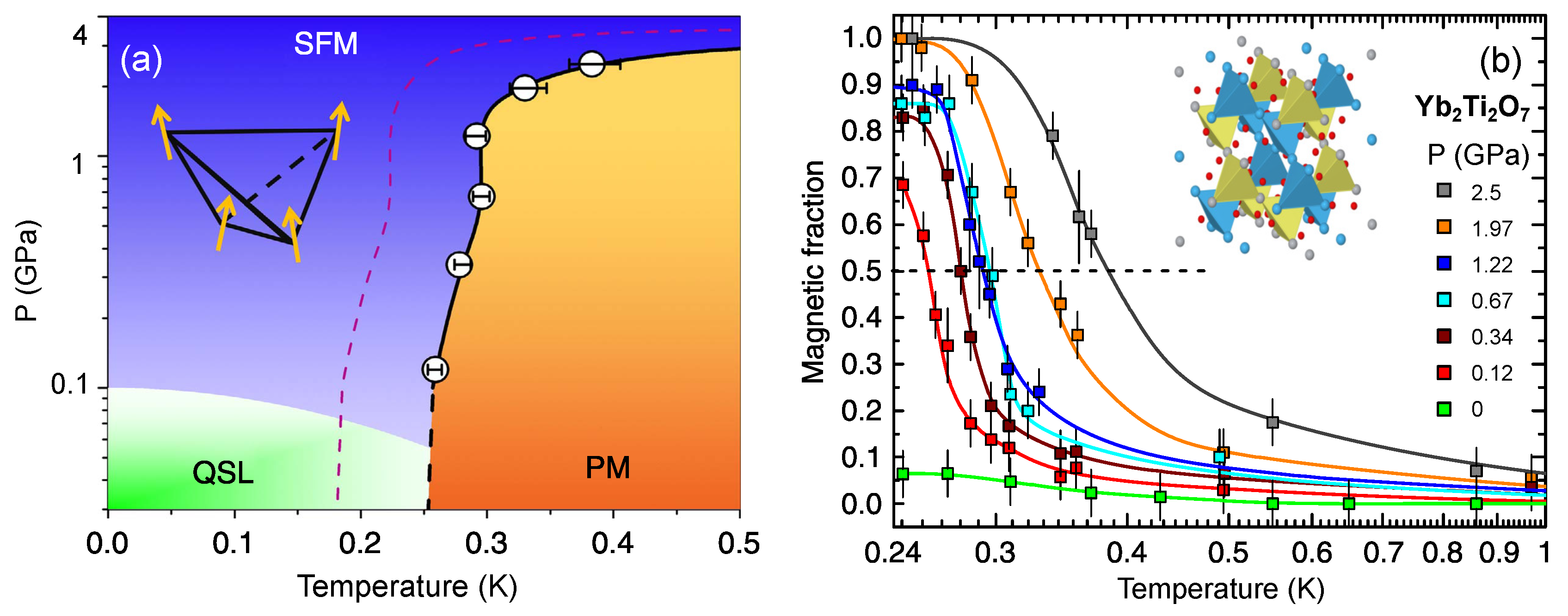
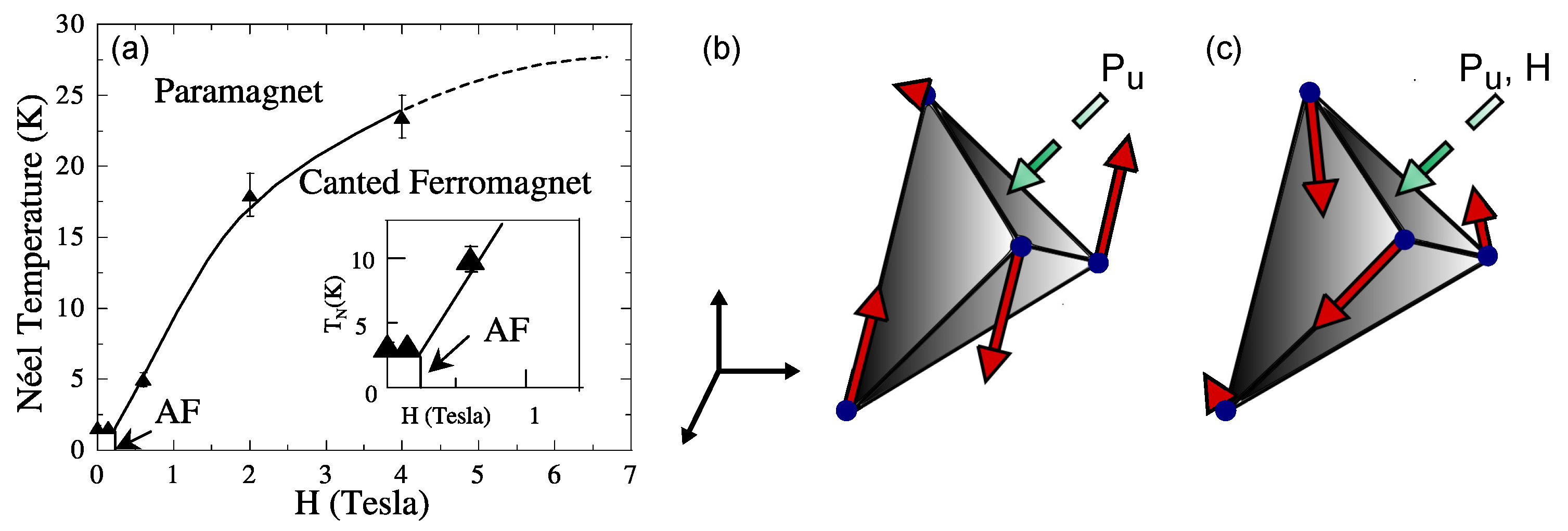
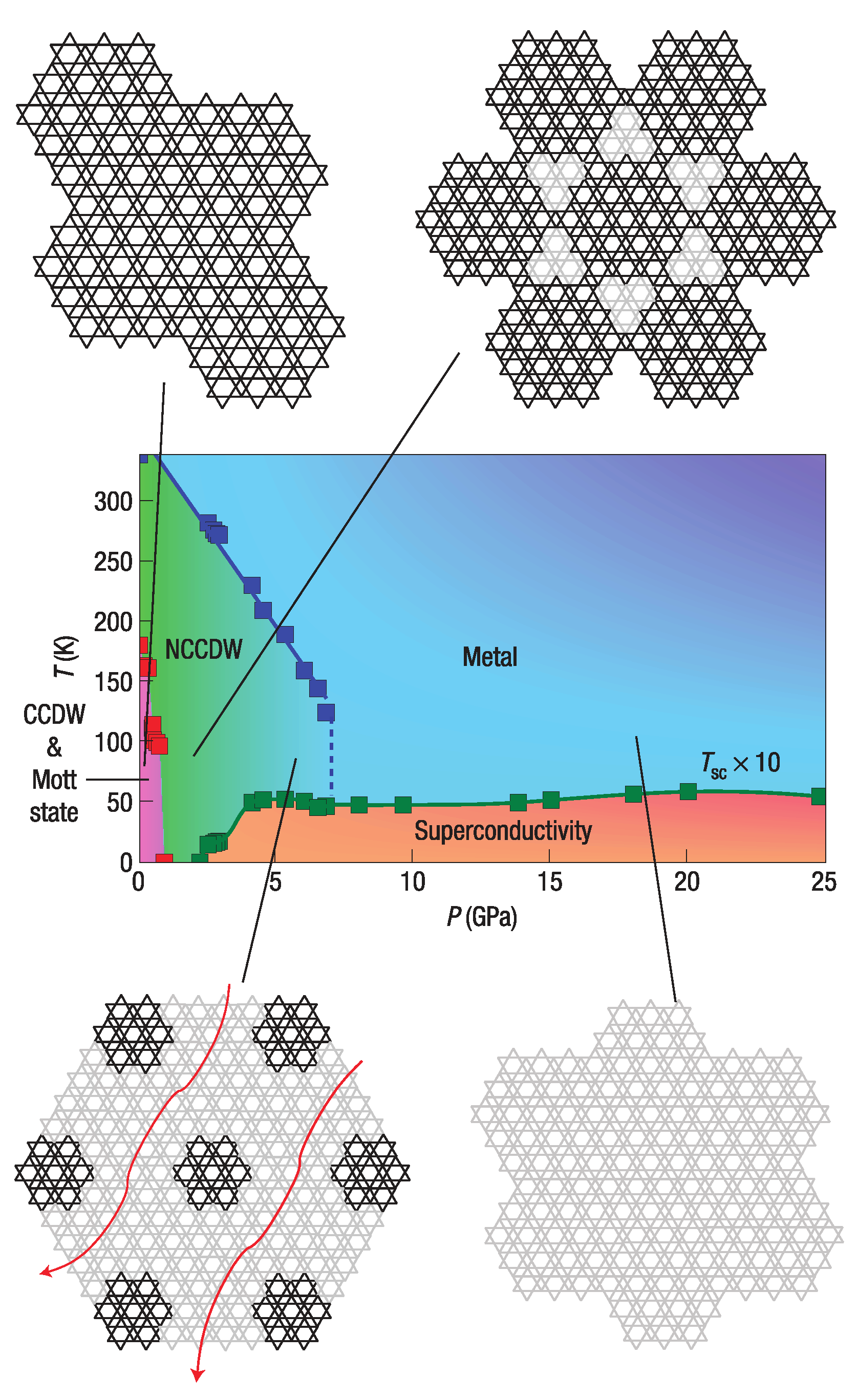
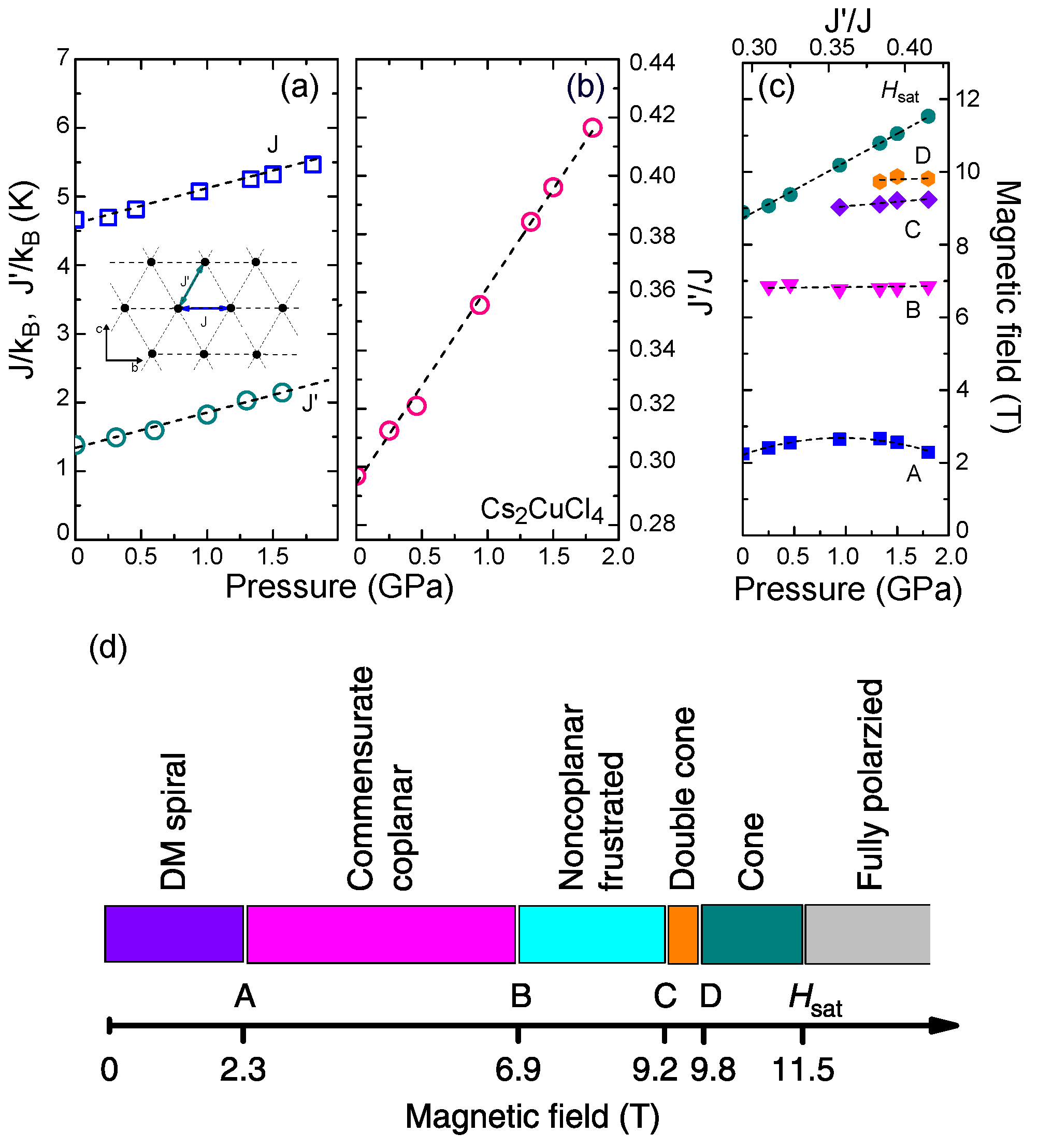
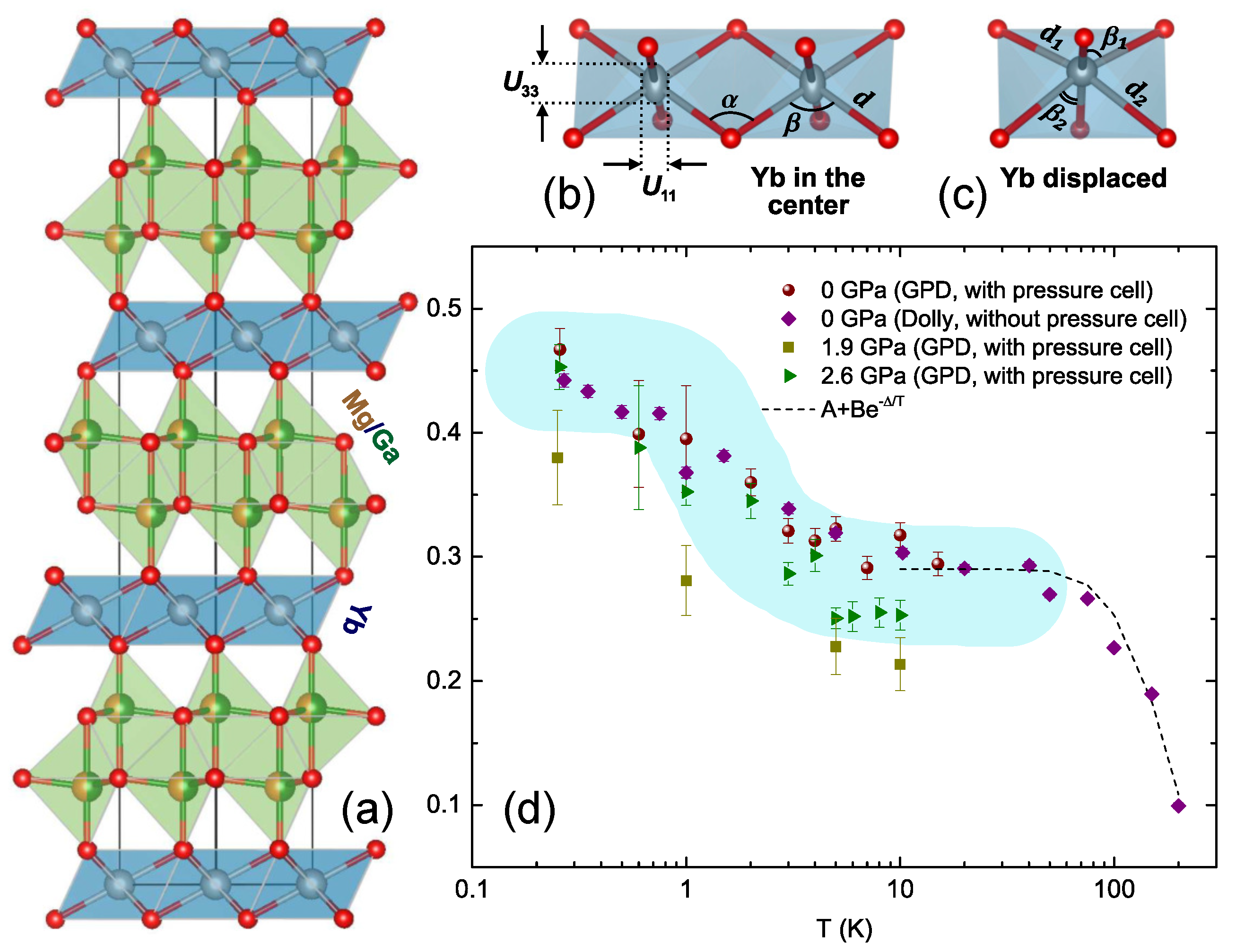
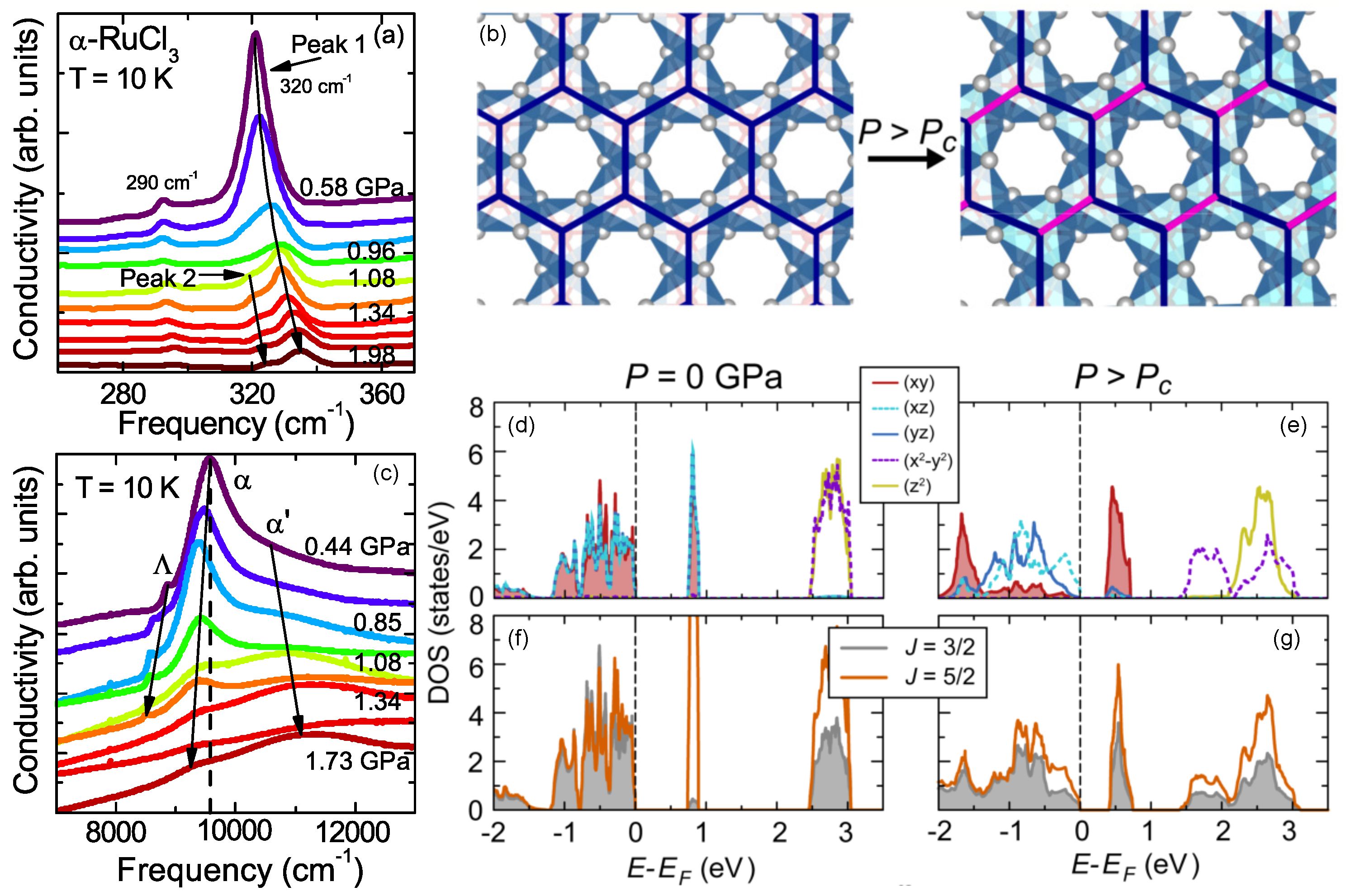

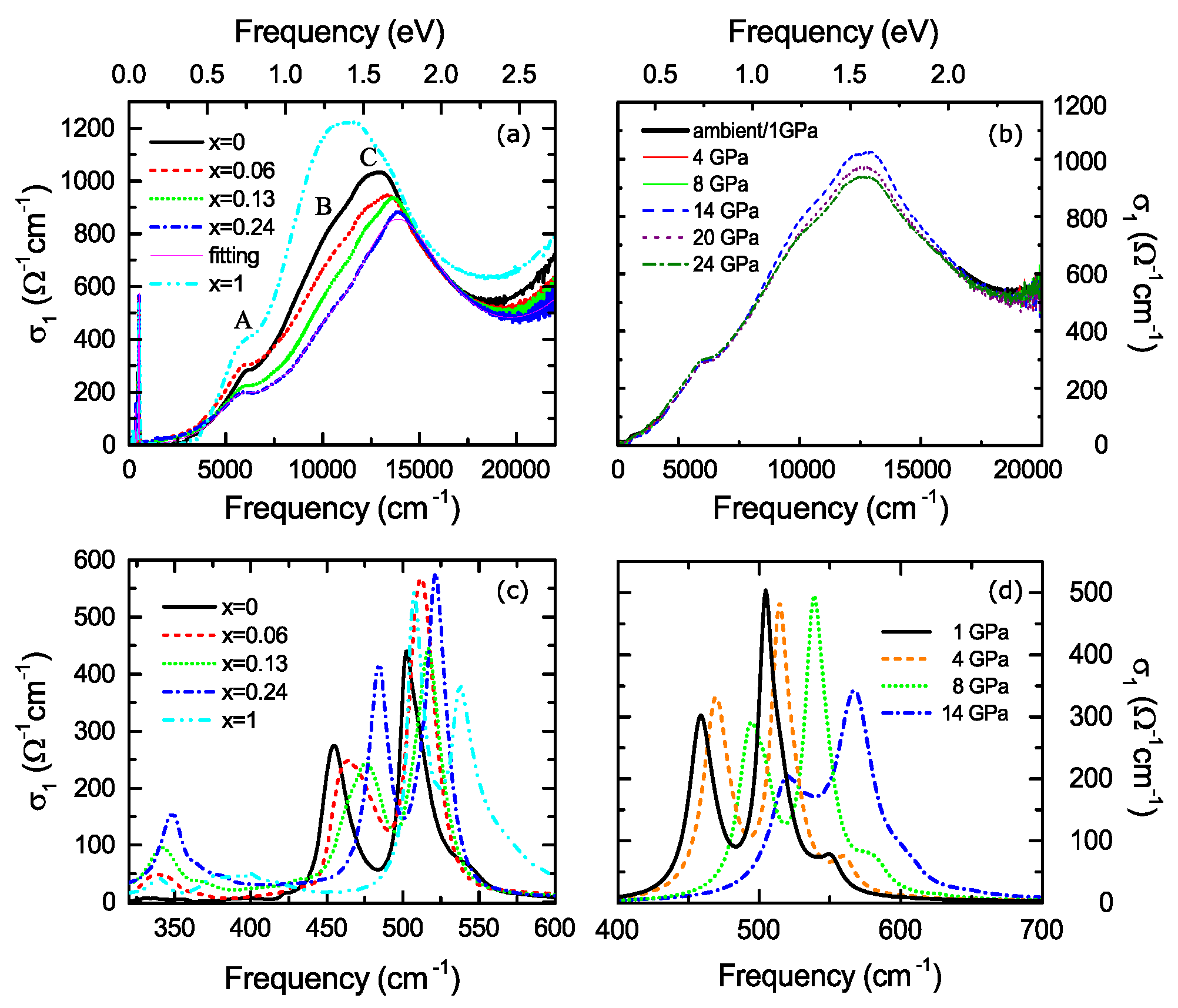
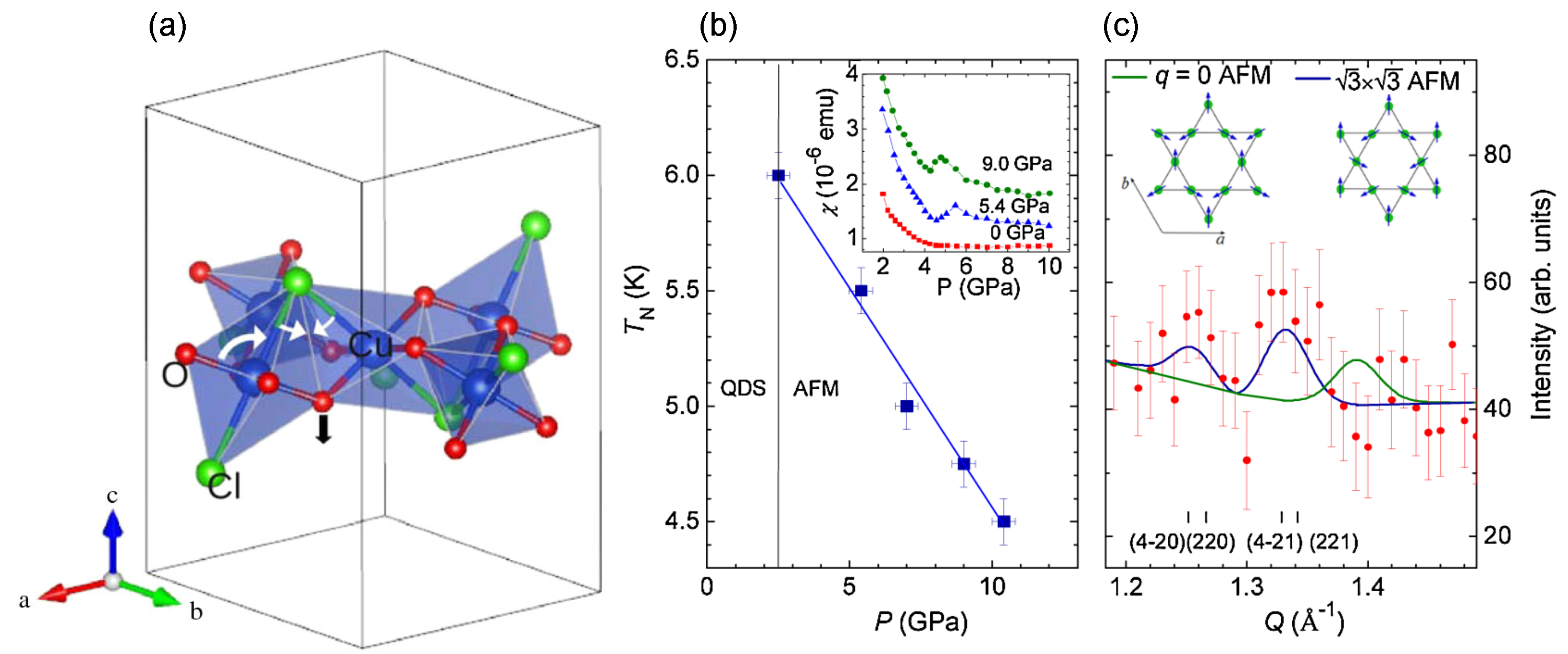

© 2019 by the authors. Licensee MDPI, Basel, Switzerland. This article is an open access article distributed under the terms and conditions of the Creative Commons Attribution (CC BY) license (http://creativecommons.org/licenses/by/4.0/).
Share and Cite
Biesner, T.; Uykur, E. Pressure-Tuned Interactions in Frustrated Magnets: Pathway to Quantum Spin Liquids? Crystals 2020, 10, 4. https://doi.org/10.3390/cryst10010004
Biesner T, Uykur E. Pressure-Tuned Interactions in Frustrated Magnets: Pathway to Quantum Spin Liquids? Crystals. 2020; 10(1):4. https://doi.org/10.3390/cryst10010004
Chicago/Turabian StyleBiesner, Tobias, and Ece Uykur. 2020. "Pressure-Tuned Interactions in Frustrated Magnets: Pathway to Quantum Spin Liquids?" Crystals 10, no. 1: 4. https://doi.org/10.3390/cryst10010004
APA StyleBiesner, T., & Uykur, E. (2020). Pressure-Tuned Interactions in Frustrated Magnets: Pathway to Quantum Spin Liquids? Crystals, 10(1), 4. https://doi.org/10.3390/cryst10010004





